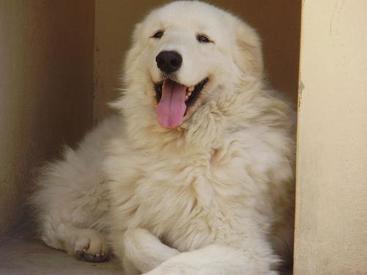
An old Hungarian flock guardian, the Kuvasz has enjoyed a colourful history. Thought to have descended from Tibetan dogs in its early homeland, the Kuvasz developed in Hungary, becoming the modern dog we know today. Primarily bred as a guardian to livestock and homestead, the Kuvasz became popular during the 15th century, commonly observed on large estates and alongside herdsmen. Favoured by King Matyas I who reigned from 1458-1490, the Kuvasz established a concrete reputation for itself as a personal protection and versatile working dog, often presented as gifts to visiting nobles or honoured guests. Owning a Kuvasz was eventually restricted, a sanction that caused numbers to diminish significantly; following the death of King Matyas I, ownership was again re-opened, with Kuvasz numbers gradually increasing. This was nearly undone with the onset of WWII, with many Kuvaszs being slaughtered by German and Soviet soldiers. Officially recognised by the AKC in 1931.
The original forebears of the breed are widely thought to be the Maremma Sheepdog, Anatolian Shepherd and Polish Tatra Sheepdog, with or without the contribution of Great Pyrenees blood. With a solid and powerful build, defined muzzle, a black nose and lips, the Kuvasz is highly distinctive and bears a striking resemblance to its ancestors. The dense double coat is typically wavy, with straight coats being disallowed in the show ring. Commonly coloured white and cream with pigmentation, the Kuvasz's coat was selectively chosen to serve herdsmen in identifying their dogs from wolves, whilst helping the Kuvasz to blend in amongst the sheep.
A highly intelligent breed with good trainability; the Kuvasz originated as a heavy, working breed and maintains an instinctual working temperament today. With a weight ranging up to 52 kg depending on gender and a life expectancy of 10-12 years, the Kuvasz is a resilient and vigilant breed, alert to threat and change. With an easy, sedate temperament, this is the ideal breed choice for families, whilst being a great companion for a sole owner. Very active-minded, the Kuvasz benefits from wide outdoor spaces where it can exercise and play.
Re-bred for its inherent hardiness, the Kuvasz is not susceptible to many breed-specific health complaints, but like most dogs, may potentially be afflicted by hip dysplasia and optical disorders. Bloat and gastric tortion have been identified in the breed due to its large size, two potentially fatal conditions if left untreated for any length of time. Otherwise, the Kuvasz is known to suffer with von Willebrand's Disease, a rare bleeding disorder.
Do you own a Kuvasz? Let others know what they're like!
Related products
Advantage 80 Spot On Flea Control Large Cats and Rabbits
from £12.95
Advantage 40 Spot On Flea Control Cats, Small Dogs and Rabbits
from £12.95
Advantage 100 Spot On Flea Control Medium Dog
from £12.95
Advantage 250 Spot On Flea Control Large Dog
from £12.95
Drontal Tasty Bone Wormer Tablets for Small & Medium Dogs (2 to 20kg)
from £2.15
FRONTLINE Plus Flea & Tick Treatment Dogs & Cats
from £17.49
TermaWorm™ Tablets for Cats & Dogs
from £1.59
Drontal Tasty Bone XL Wormer Tablets for Large Dogs (Over 20kg)
from £6.39